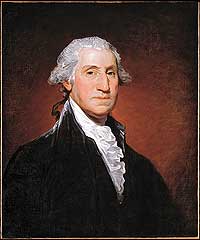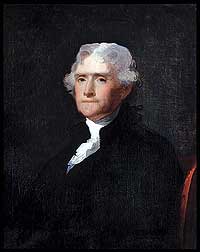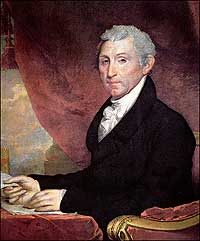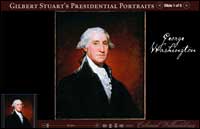Presidential Portraits
"Stuart is all the rage, he is almost worked to death...."
by Ellen G. Miles
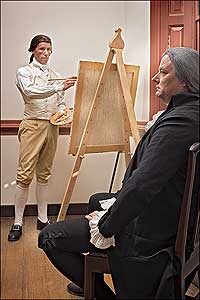
Colonial Williamsburg's Ron Carnegie as George Washington sits for painter Gilbert Stuart, in the person of Robb Warren.
The best known and most admired American portrait painter of the early Republic, Gilbert Stuart, took from life the images of its first five presidents—George Washington, John Adams, Thomas Jefferson, James Madison, and James Monroe—copying them for a market of admirers. Colonial Williamsburg owns and exhibits his original of Madison, an early replica of his Jefferson, and one of about a dozen versions of the first of his three paintings of Washington.
Called by fellow artists the Father of American Portraiture, Stuart was born at Kingston, Rhode Island, on December 3, 1755—the year Washington joined Major General Edward Braddock's army in the French and Indian War and the Father of His Country began his rise to fame. His parents were Gilbert Stuart, an immigrant Scottish snuff maker, and his wife, Elizabeth. His family moved to Newport when he was seven, and there in 1769 an itinerant Scotsman, Cosmo Alexander, introduced him to painting. Alexander and the boy set off for training in Scotland in 1770, but Alexander died in 1772, and Stuart worked his way home on a collier. He traveled in 1775 to study under Benjamin West and Joshua Reynolds in London, where he gained success and prominence. In 1787, he moved to Dublin and dominated Irish portrait painting until 1793, when he returned to America to paint Washington.
Stuart, always short of cash, intended to capitalize on the growing demand for portraits of the first president. Washington sat for him in 1795 and 1796, near the end of Washington's second term in office, in Philadelphia, the temporary national capital. Washington had grown suspicious of the motives of artists, and it took the persuasion of relatives and close friends to secure his cooperation. Stuart produced three compositions known today from the names of early owners as the Vaughan type, the Athenaeum type, and the Lansdowne type.
Colonial Williamsburg's is one of a dozen of the Vaughan type, painted in 1795. By comparison, Stuart made about seventy-five replicas of his second life portrait of Washington, known as the Athenaeum because of its longtime owner, the Boston Athenaeum. The Vaughan name derives from the portrait that John Vaughan of Philadelphia sent to his father, London merchant Samuel Vaughan, long thought to be the life portrait. The first owner of Williamsburg's copy was Virginia Governor HenryLee. He, like John Vaughan, acquired the portrait in 1795 from the artist. They are named in Stuart's "List of gentlemen who are to have copies of the Portrait of the President of the United States," which the artist compiled April 20, 1795. Lee, a major general during the Whiskey Rebellion in 1794, is listed as "Gen. Lee."
Lee also served with Washington during the Revolution, earning the nickname Light-Horse Harry for his service in the First Continental Light Dragoons. After the war he sat in the Virginia House of Delegates and the Continental Congress before being elected governor for three consecutive one-year terms, 1791–94. A member of the sixth United States Congress, Lee wasselected to give the congressional eulogy after Washington's death in 1799. He said the president was "first in war, first in peace, and first in the hearts of his countrymen."
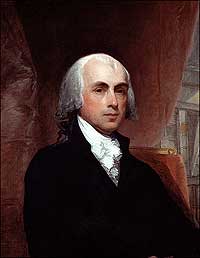
Madison, above, and Monroe are two more Stuart presidential portraits, of the five he painted, in the Colonial Williamsburg collection.
Stuart's daughter Jane recorded an anecdote about her father and Lee, whose portrait Stuart also painted at about this time. Stuart prided himself on being able to detect a sitter's character and temperament from examination of his features. He had studied anatomy in London in the 1780s and remained in touch with Henry Fuseli, an artist interested in physiognomy. When Fuseli selected images to be engraved for a multivolume English translation of Johann Caspar Lavater's Essays on Physiognomy, he included the Vaughan version of Stuart's portrait of Washington. Jane Stuart wrote that, at the time of Washington's sittings in Philadelphia, her father told Lee that Washington had a tremendous temper, but held it under wonderful control. General Lee breakfasted with the President and Mrs. Washington a few days afterward. "I saw your portrait the other day—a capital likeness," said the General, "but Stuart says you have a tremendous temper." "Upon my word," said Mrs. Washington, coloring, "Mr. Stuart takes a great deal upon himself, to make such a remark." "But stay, my dear lady," said General Lee, "he added, that the President had it under wonderful control." With something like a smile, General Washington remarked, "He is right."
Such anecdotes about Stuart's relationship with Washington are abundant and revealing. Washington's references to Stuart consist of one letter and one diary entry that refer matter-of-factly to appointments.
Stuart painted Colonial Williamsburg's portrait of President Jefferson in 1805 in Washington, D.C., at the beginning of Jefferson's second term. Jefferson had commissioned Stuart to paint his portrait five years earlier in Philadelphia, just before the government moved to the District of Columbia. Jefferson wrote in 1819:
With respect to mr. Stuart, it was in May 1800, I got him to draw my picture, and immediately after the last sitting I paid him his price. he was yet to put the last hand to it, so it was left with him. when he came to Washington in 1805, he told me he was not satisfied with it, and therefore begged me to sit again, and he drew another which he was to deliver me instead of the first, but begged permission to keep it until he could get an engraving from it.
The new sittings came about because James Bowdoin III commissioned Stuart to paint a pair of portraits of Jefferson and his secretary of state, Madison. Bowdoin had been appointed minister to the Court of Spain, and wished to have the portraits sent to him there. When Stuart painted Jefferson's large, seated portrait for Bowdoin, he also painted the head and shoulders version for Madison owned by Colonial Williamsburg.
The freshness and liveliness of this smaller portrait led art historians Charles Merrill Mount and David Meschutt to identify it as the portrait painted from life in 1805. Nevertheless, when, after Madison had succeeded him as chief executive, Jefferson described Stuart's portraits of himself to Philadelphia publisher and print seller Joseph Delaplaine in 1814, he wrote from Virginia: "The two original portraits of myself taken by mr Stuart, after which you enquire, are both in his possession at Boston. One of them only is my property. the President has a copy from that which Stewart considered as the best of the two; but I believe it is at his seat in this state." Two years later Jefferson again characterized the painting as a copy: "I have no doubt the copy of my portrait at the President's residence in Orange (3 miles off the stage road) is as good as the original in the possession of Stewart."
Madison obtained the Jefferson portrait before Stuart moved to Boston in the summer of 1805, soon after the sittings. After Madison's death the portrait was sold to Judge Edward Coles, private secretary to Madison during his presidency. Coles's descendants owned it until John D. Rockefeller Jr. acquired it in 1945 for Colonial Williamsburg.Stuart did not complete the portraits he painted for Bowdoin in time to send them to the minister in Europe; they were delivered to Bowdoin in Boston in 1807. He willed them on his death to Bowdoin College, established in Brunswick, Maine, and named for his father, James Bowdoin II.
Stuart had studios in New York and Philadelphia, moved to Washington, and finally settled in Boston in 1805. Jefferson wrote to him in 1814:
With a high veneration for your talents, & sincere good wishes that they might have abundant employment for the establishment of your own happiness and fame, I learned with pleasure the extensive work in which you were engaged in Boston. yet nature having spread with pretty equal hand her gifts of worth and wisdom over the different parts of the Union, it would have been more consonant with her plan, & our wishes, that your talents should have been applied to their commemoration with the same equal hand. your former central position was more favorable to this, and certainly you could never there have been without more than you could do. I do not think, with some, that man is so far the property of society as that it may command the use of his faculties without regard to his own will or happiness: but it is at least to be wished that the inclination should generally be coupled with the power of aiding the reasonable objects of those with whom we live; and I am not without a hope that you will resume the function of leaving to the world your own excellent originals rather than copies from inferior hands of characters of local value only. pardon these observations. they flow not merely from considerations of public concern, but equally from great personal regard, and the desire that the employment of your talents should be worthy of their dignity. I add with great sincerity assurances of my high respect and consideration.
Within the next few years Jefferson tired of waiting for Stuart to send him the painting for which he had paid. Stuart finally dispatched a portrait to Jefferson in 1821 to fulfill the commission. Assumed for years to be the life portrait of 1805, it is known as the Edgehill portrait from its ownership by Jefferson's descendants, the Randolphs, at Edgehill, Albemarle County. It now is owned by the Thomas Jefferson Foundation at Monticello and the Smithsonian National Portrait Gallery. The Edgehill portrait is now, however, believed to have been painted shortly before its delivery. The life portrait may have been destroyed by fire in the Library of Congress in 1851, when a series of portraits of the first five presidents by Stuart was there on view.
When Madison succeeded Jefferson as president in 1809, Stuart had already painted the Madison portrait owned by Colonial Williamsburg. Stuart painted Madison and his wife, Dolley, in 1804, intending the pair of portraits as pendants, posing the figures turned toward each other, typical of paired paintings of husband and wife.Stuart had traveled to Washington in December 1803 from Philadelphia and by the spring of 1804 was in demand. The Madisons were among his first sitters. A contemporary wrote: "Stuart is all the rage, he is almost worked to death, and everybody afraid that they will be the last to be finished. He says 'the ladies come and say "Dear Mr. Stuart, I am afraid you will be very much tired, you really must rest when my picture is done. Mrs. Robert Smith is sitting now, so is Mr. Madison."'" Smith's husband was the secretary of the navy. The First Lady-to-be wrote to her sister Anna Payne Cutts on May 20: "Steward has taken an admirable picture of Mr. Madison—his & mine are finished—Mrs R Smiths is nearly done but she does not like it tho tis verry like her."
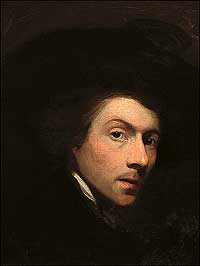
Courtesy of Redwood Library
Of the more than a thousand portraits Gilbert Stuart made, this quizzical self-portrait was done at age twenty-four.
Dolley Madison hoped Stuart would remain in Washington. She wrote to sister Anna again: "Dr. & Mrs. Thornton sat yesterday to Stuart for the last time. He has now nearly finished all & says he means to go immediately to Boston, but he has been going these two years—He is a man of genius, and therefore does everything differently from other people—He travels to the Southward on his way Northward," a reference to his plan to move on to Boston. The pose of his Madison portrait decided how Stuart would pose Madison and Jefferson in the pair of portraits commissioned byBowdoin, because Stuart copied Madison's image for that second painting, with changes in the position of the arms.
During Madison's presidency, the portraits were displayed in the White House, known then as the President's House. When the British army attacked during the War of 1812, the paintings were removed for safekeeping. Dolley Madison wrote: "There ware upon the Walls two or three Engravings, by Edwin of Mr Madison and myself, with large Portraits of both, by Stewart—the latter, were removed before the British entered, and the former, we understood, were taken by the destroyers of the building." Dolley also rescued the White House version of Stuart's full-length Lansdowne portrait of Washington, which the government purchased in 1800.As the British army approached the city August 23, 1814, Dolley Madison ordered the painting taken out of its frame and carried to safety. She wrote to her sister Lucy:
I insist on waiting until the large picture of Gen. Washington is secured, and it requires to be unscrewed from the wall. This process was found to be too tedious for these perilous moments; I have ordered the frame to be broken, and the canvass taken out it is done, and the precious portrait placed in the hands of two gentlemen of New York, for safe keeping. And now, dear sister, I must leave this house, or the retreating army will make me a prisoner in it, by filling up the road I am directed to take.After the rebuilding of the President's House, left in ruins by the British, the full-length Washington was returned and is on view there today. After Madison's presidency, he and his wife kept their own portraits at Montpelier, their Virginia estate. The paintings were separated after her death in 1849. Judge Coles purchased James Madison's when he acquired Jefferson's. The painting came to Colonial Williamsburg in 1945 as the gift of his granddaughter Virginia C. Coles—Mrs. George S. Robbins. Dolley Madison's portrait, acquired by her niece Anna Payne Causten, is owned by the White House.
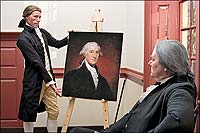
The Vaughan Washington is one of three types Stuart made of the president, with scores of copies that he sold for $100 apiece.
Stuart made fewer duplicates of his portraits of Jefferson and Madison than of Washington's, which he referred to as his "one hundred dollar bills," $100 being his price for a head and shoulders painting. Perhaps if he had not moved to Boston, this would have been different. Like Jefferson, Dolley Madison regretted his departure from the federal capital. In 1812 she wrote to her friend Ruth Barlow in Paris on the lack of a good portrait painter in the city: "I wish I could gratify you my dear friend, with the Portraits you mention, but I see little prospect of doing so. Steward is far from us & we have no Painter of skill in this quarter."
In 1821, however, Stuart painted two duplicates of his Jefferson and Madison portraits. For two series of paintings of the first five presidents, Stuart copied his life portraits of the men. One set of five, painted for George Gibbs Jr. and known as the Gibbs-Coolidge series, belongs to the National Gallery of Art in Washington. Of the other series, painted for Boston framer and gilder John Doggett, only the portraits of Madison, now at the Mead Art Museum, Amherst College, and Monroe, owned by the Metropolitan Museum of Art, survive.
Those of Washington, Adams, and Jefferson were destroyed in the 1851 Library of Congress fire while being considered for acquisition by the government. John Doggett commissioned a series of lithographs made from them titled The American Kings, the only record of the lost images.
Stuart, who painted more than a thousand portraits of notable people and their families, died in Boston on July 9, 1828.
Ellen G. Miles, curator and chair of the department of painting and sculpture at the National Portrait Gallery at the Smithsonian Institution, is the author of such works as American Paintings of the Eighteenth Century and George and Martha Washington: Portraits from the Presidential Years, and with Carrie Rebora Barratt, is co-author of Gilbert Stuart, the catalogue for the 2004 Metropolitan Museum of Art exhibition. This is her first contribution to the journal.

